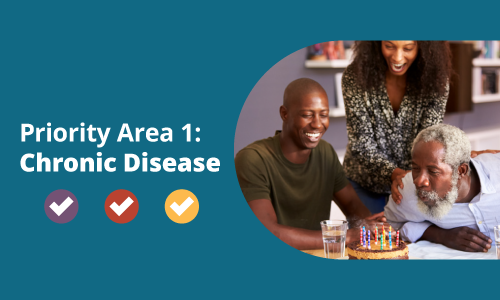The CHIP chronic disease subcommittee recognized smoking, and tobacco use in general, as an important determinant of multiple chronic diseases and identified tobacco control efforts as a key mechanism for reducing the burden of chronic disease in the Southern Nevada community.

Goal 1: Decrease the prevalence of heart disease among those identified (Non-Hispanic Black/ African American, 65 and Older, by ZIP Codes)
Objective 1.1: By December 2025, advocate for and attempt to secure increased funding for tobacco control to CDC recommended funding levels as well as other chronic disease programs.
Action Step: Meet with Legislators to raise awareness and justify need for additional funding.
Action Step: Promote existing tobacco programs and the connection to reduced chronic disease.
Action Step: Identify funding priorities, best practices, and potential collaborations with local and statewide partners.
Goal 2: Decrease the prevalence of lower respiratory disease among those identified (Non-Hispanic Black/African American, 65 and Older, by ZIP Codes)
Objective 2.1: By December 2025, implement CDC or national model policy and law for secondhand smoke protection.
Action Step: Develop educational materials for distribution to legislators that share the model policies and the disproportionate impact of those policies on communities of color.
Action Step: Develop a tracker for model policy implementation
Action Step: Identify populations or communities not covered by tobacco policy.
Action Step: Meet with decision makers to promote and encourage secondhand smoke protection by creating smoke-free law/policies
Action Step: Review current model policies and the applicability for the state of Nevada
Action Step: Increase opportunities and awareness for establishments to go smoke-free based on positive "rewards".
Objective 2.2: By December 2025, decrease smoking prevalence in the non-Hispanic Black/African American, 65 and older, and geographic area.
Action Step: Promote tobacco cessation resources in the community
Action Step: Fund qualitative assessments to understand the lived experience of people from the identified communities that use tobacco
Action Step: Provide incentives for tobacco cessation
Goal 3: Decrease the prevalence of cancer among those identified (Non-Hispanic Black/African American, 65 and Older, by ZIP Codes)
Objective 3.1: By December 2025, decrease tobacco-related cancers for non-Hispanic Black/African-American, 65+, and those living in specific geographic areas.
Action Step: Increase access to healthy foods to use nutrition to promote prevention of the diseases.
Action Step: Use community health workers for increased health promotion and advocacy.
Action Step: Promote wellness checks and free wellness fairs and screenings.
Action Step: Targeted media initiatives and outreach to increase awareness.
What the data say:
- Clark County's age-adjusted death rate due to chronic lower respiratory diseases is significantly higher than the national rate.
- Nevada allocates less than $1 million per year toward comprehensive tobacco control which is approximately 3.2% of the CDC-recommended level of $30 million annually.¹




 Significantly better than the overall value
Significantly better than the overall value Significantly worse than the overall value
Significantly worse than the overall value No significant difference with the overall value
No significant difference with the overall value